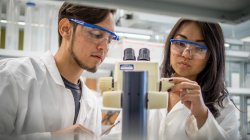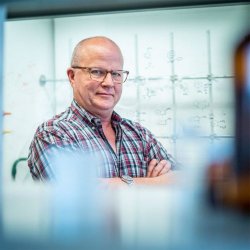
Sokol Professor, Department of Chemistry and Biochemistry
Director, Sokol Institute of Pharmaceutical Life Sciences
Dr. Rotella earned a BS Pharm degree at the University of Pittsburgh School of Pharmacy, a Ph.D. degree in medicinal chemistry from The Ohio State University and carried out postdoctoral research in synthetic organic chemistry at Penn State University.
He was an assistant professor at the University of Mississippi School of Pharmacy where he investigated natural product analogs as anticancer agents and inhibitors of phospholipase A2. When he moved into the pharmaceutical industry, he led drug discovery projects in Alzheimer’s Disease, schizophrenia, Parkinson’s Disease and anti-atherosclerotic disorders. He has been at Montclair State since 2011 where his research is focused on antimalarial drug discovery and inhibition of tyrosine kinases and phosphodiesterase enzymes, as well as discovery of novel conformationally restricted templates for G-protein coupled receptors.
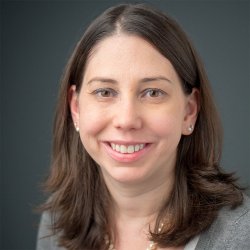
Associate Professor, Department of Chemistry and Biochemistry
Dr. Catalano research group focuses on Cytochrome P450 enzymes. In particular, CYP2S1, which is overexpressed in cancerous areas that has unique chemistry compared to other CYP enzymes. Dr. Catalano collaborates with Dr. Goodey on studying secondary structural changes of Indole-3-glycerol-phosphate synthase and Dihydrofolate reductase. In addition, Dr. Catalano maintains collaborations at the University of Delaware and Metropolitan Museum of Art where she is using different NMR techniques to investigate the structure and dynamics of soap formation leading to the deterioration of traditional oil and modern paintings.
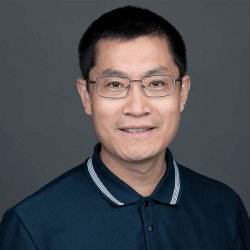
Professor, Department of Chemistry and Biochemistry
Prior to his arrival at Montclair State University, Dr. Gao pursued Ph.D. in Analytical and Organic Chemistry (2008-2012) and post-doctoral study (2012-2014) in proteomics and glycomics mass spectrometry in the laboratory of Prof. Hilkka I. Kenttämaa at Purdue and Prof. J. L. Beauchamp at Caltech, respectively. His research interests lie in 1) the development of free radical reagents for glycan and protein quantitation and characterization via free radical chemistry and mass spectrometry, and 2) the identification and discovery of potential biomarkers for cancers. Recently, the Gao group developed a fluorescence free radical tag for simultaneous glycan quantitation and characterization using UPLC-MS/MS, which will promote the study of glycans.
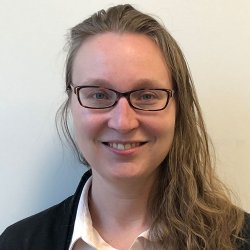
Professor, Department of Chemistry and Biochemistry
Her current research focuses on the inhibition, mechanism, and structure-activity relationships in M. tuberculosis IGP synthase and filarial dihydrofolate reductases, which are potential drug targets in the treatment of tuberculosis and elephantiasis. Her group also investigates strategies to reduce the impacts of environmental contamination on enzymatic activities and plant growth in brownfield soils. The research activities are currently funded through the National Science Foundation and the National Institutes of Health. She mentors undergraduate and graduate student researchers in her laboratory and many students have served as authors on the 40 peer-reviewed research. Dr. Goodey also serves as the Associate Director of the PSEG Institute of Sustainability Studies.
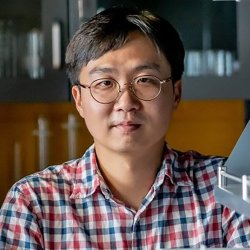
Assistant Professor, Department of Chemistry and Biochemistry
Dr. Lee’s research group studies lipid-protein interaction using bottom-up reconstitution to create minimal systems mimicking biological vesicle trafficking processes. Vesicle trafficking is a process of material transport between cellular organelles that is one of the most fundamental functions of cells. Fluorescence microscopy, synthetic lipid vesicles, protein purification, machine-learning assisted image analysis, and computer modeling are the main tools in use. From this approach, the group aims to understand the essential molecular mechanism of the biological processes, and develop functional biomimetic materials to be used in creation of artificial protocells and drug delivery.
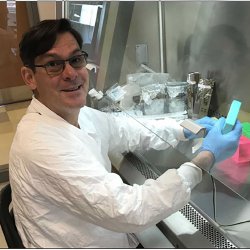
Professor, Department of Biology
Presently there are two major research areas of basic biology in my laboratory; regulation of eukaryotic cell growth and division, and regulation of gametogenesis. In the area of cell division we seek to understand the mechanisms involved in eliminating and misplacing a protein with cell growth suppression activity using cells in culture and animal models. The long term expectation is that this research will set the stage to test agents to specifically inhibit the degradation and abnormal localization of this protein in diseases such as cancer. In the area of reproductive biology we are studying the molecular mechanisms of ovulation and spermatogenesis using gonads-specific transgenic animals as models. These studies may lead to the development of new technologies in the field of agricultural livestock, where higher reproductive success is desired. Further research in this area could also lead to the development of novel reproductive technologies.
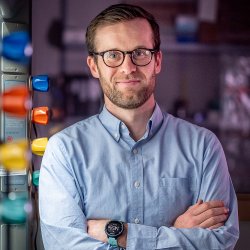
Associate Professor, Department of Chemistry and Biochemistry
Glen O’Neil earned a B.S. in Chemistry from the University of Delaware and a Ph.D. in Chemistry from Tufts University working with Sam Kounaves. He joined the faculty at Montclair State in 2016 after postdocs at the University of Warwick with Julie Macpherson and Columbia University with Dan Esposito. His group works on developing creative new tools for making electrochemical measurements in complex systems. He has received a CAREER Award from the NSF and a Cottrell Scholar Award from the RCSA.
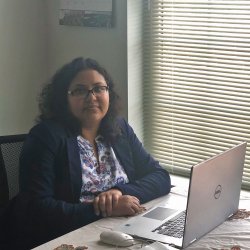
Assistant Professor, Department of Chemistry and Biochemistry
Amrita Sarkar earned her Ph.D. in Chemistry at the University of South Carolina under the direction of Professor Morgan Stefik, with a thesis entitled “Block Copolymer Control of Nanoscale Porous Materials.” Before joining Montclair State University in 2020, Sarkar spent two years as a postdoctoral fellow at the Rensselaer Polytechnic Institute and Columbia University. Research in Sarkar Group seeks to develop a thorough understanding of how to effectively design nature-inspired synthetic macromolecules and incorporate them in the next generation energy devices. Sarkar group is currently collaborating with Columbia University, New Jersey Institute of Technology and Rutgers University in the areas of biogenic solvent exploration in energy devices, biocompatible sensor making and electron microscopy use in polymer structure, respectively. The group is keen to collaborate in exploring the bio-inspired synthetic polymer in controlled drug delivery.
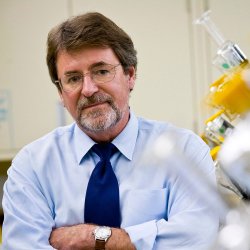
Herman and Margret Sokol Professor of Medicinal Chemistry.
Dr. Siekierka’s career consists of 22 years of drug discovery research in the pharmaceutical industry and an additional 16 years of academic drug discovery research and teaching at Montclair State University. Dr. Siekierka’s research focuses on drug discovery for treating parasitic diseases, in particular, malaria and lymphatic filariasis, as well as oncology.
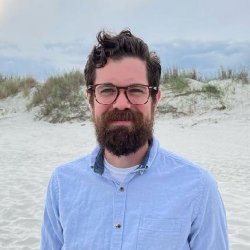
Assistant Professor, Department of Biology
I graduated from Arizona State University with a bachelor’s degree in psychology in 2011. I then attended Wesleyan University, where I completed a PhD in neurobiology and behavior researching the comparative development of the cerebellum and surrounding hindbrain. During this project, I discovered that one conserved mediator of cerebellar development is actually an immune molecule, sparking my interest in neuro-immunology. After my PhD, I moved to Princeton University where I did my postdoctoral research at the Princeton Neuroscience Institute in Lisa Boulanger’s laboratory. Here, I researched immune-mediated effects of viral vectors on cortical circuits.
My lab at MSU is interested in the interplay between the nervous and immune systems under normal and pathological conditions. One goal of our lab is to understand how host immune responses to neurotropic viruses can disrupt circuit structure, function and development. Recombinant adeno-associated viruses (AAVs) have revolutionized neuroscience research and are used to deliver human gene therapies to the nervous system. By identifying unintended effects of the host antiviral response in the brain, we can find preventative solutions to improve the safety and efficacy of viral vectors for neuroscience research and human gene therapy.
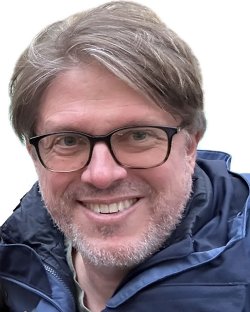
Associate Professor, Department of Chemistry and Biochemistry
Dr. Talaga earned the AB Degree in Chemistry and Mathematics from Occidental College, the Ph.D. in Physical Chemistry from UCLA, and was an NIH NRSA Postdoctoral Fellow at the University of Pennsylvania.
Prof. Talaga started his independent career as Assistant Professor of Chemistry at Rutgers, New Brunswick. While there, he investigated single molecule approaches to protein aggregation and amyloid formation. One key discovery was the impact of interfaces on the initiation of fibrilization of α-synuclein and its relationship to Parkinson’s disease. His papers have been featured on the covers of J. Mol. Bio. an J. Phys. Chem. After being promoted to Associate Professor he moved his research program to Montclair State University. At MSU Prof. Talaga has focused on the factors controlling the initiation of the formation of amyloid fibrils in disease-related proteins like α-synuclein and in polypeptide drugs during formulation, manufacturing, and storage.
